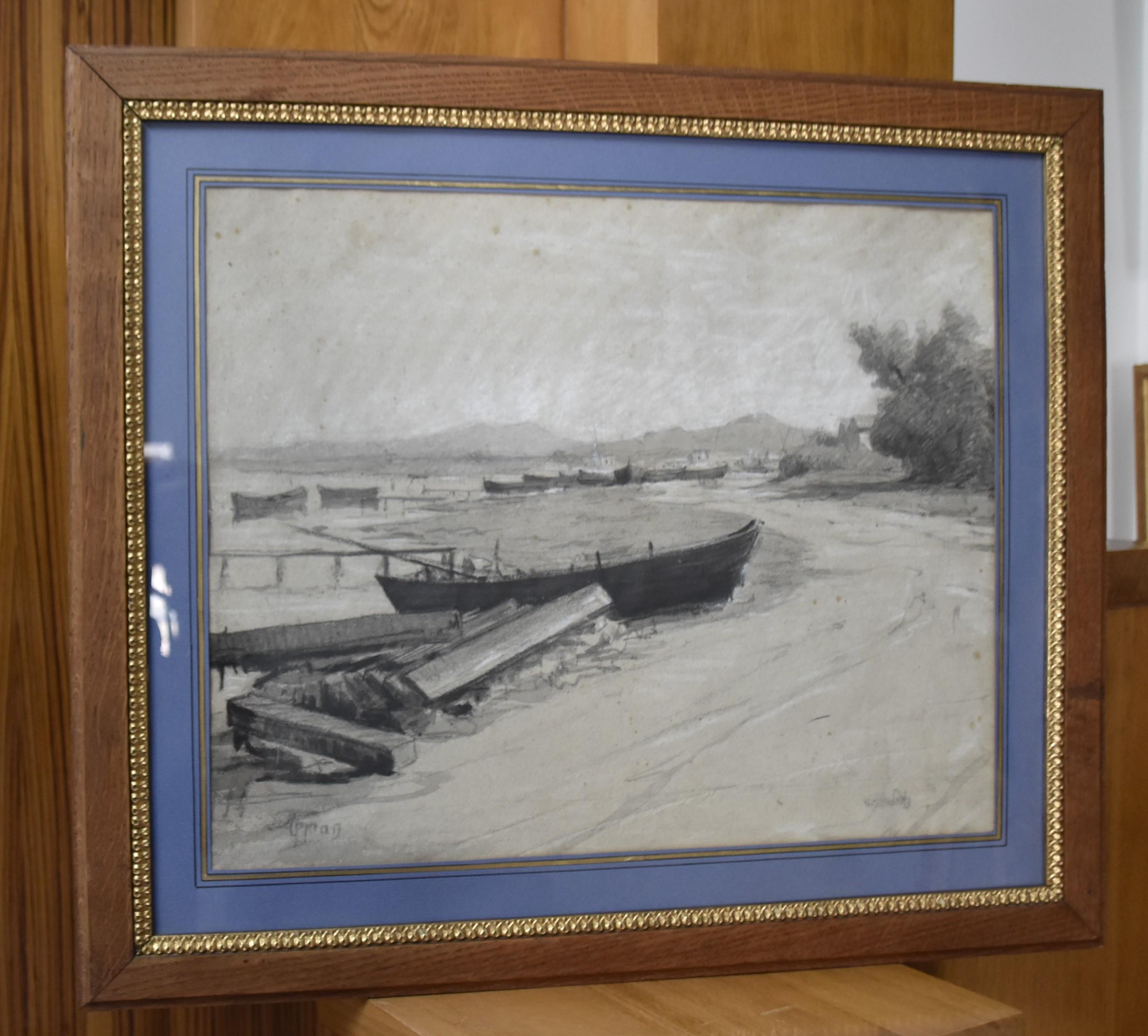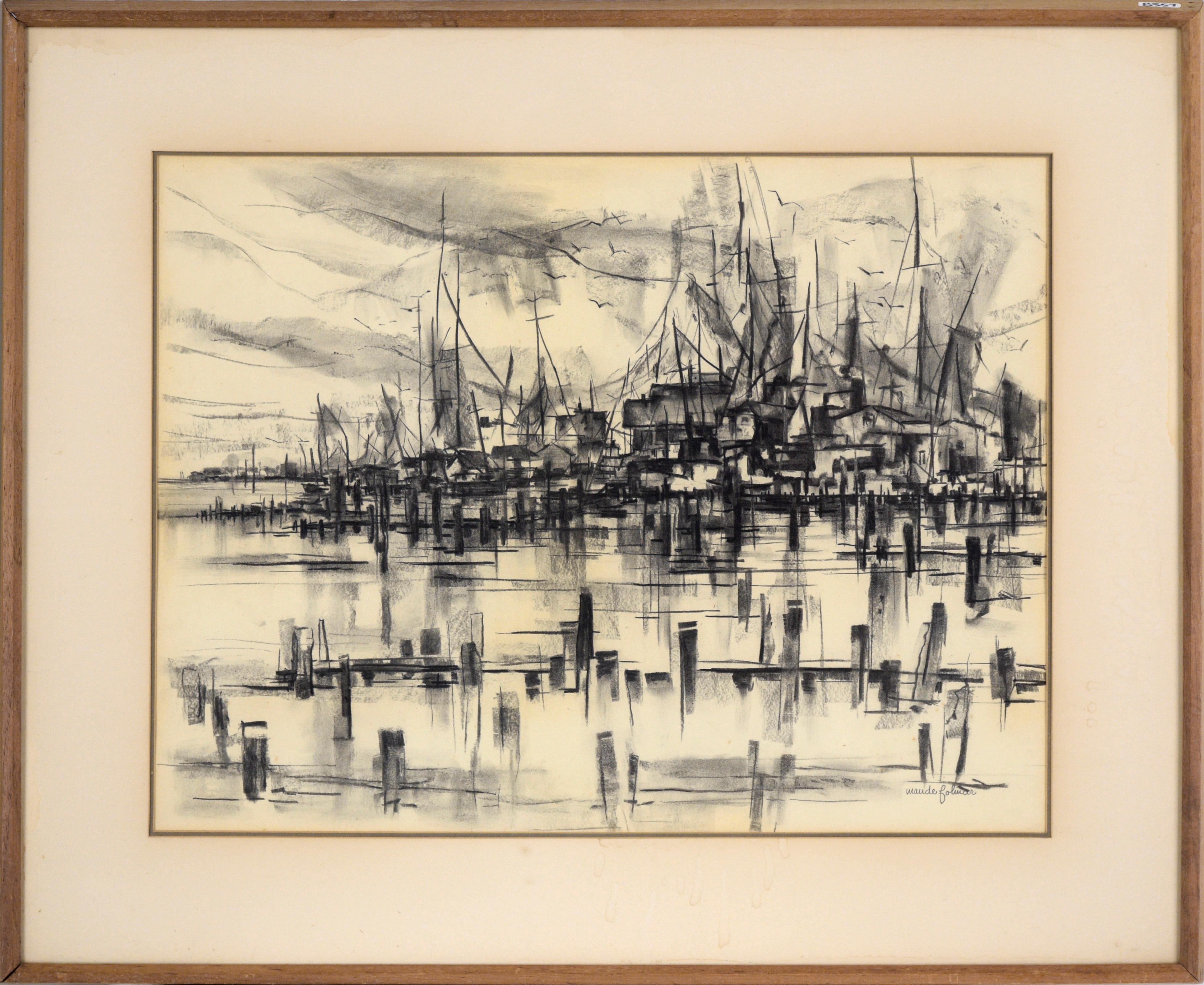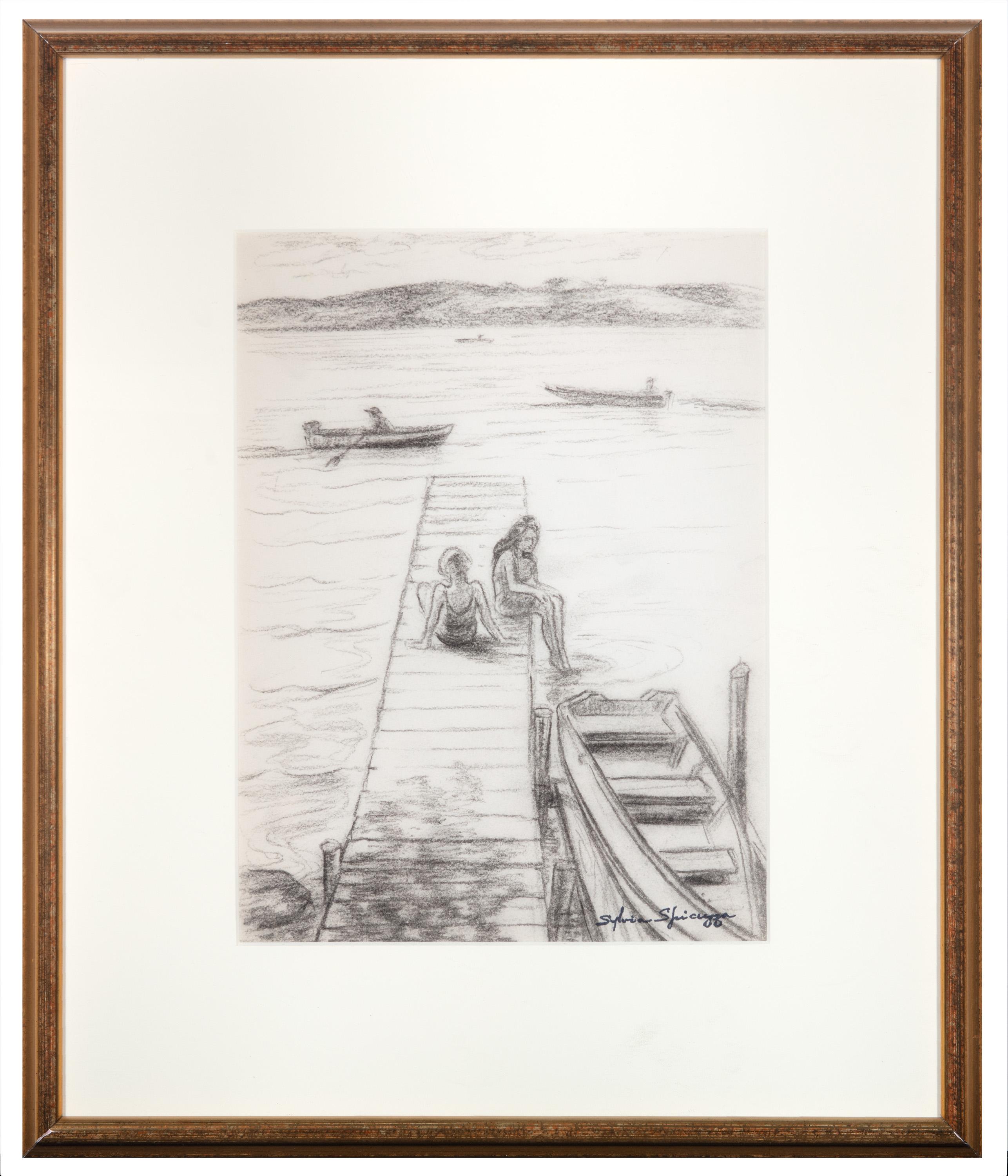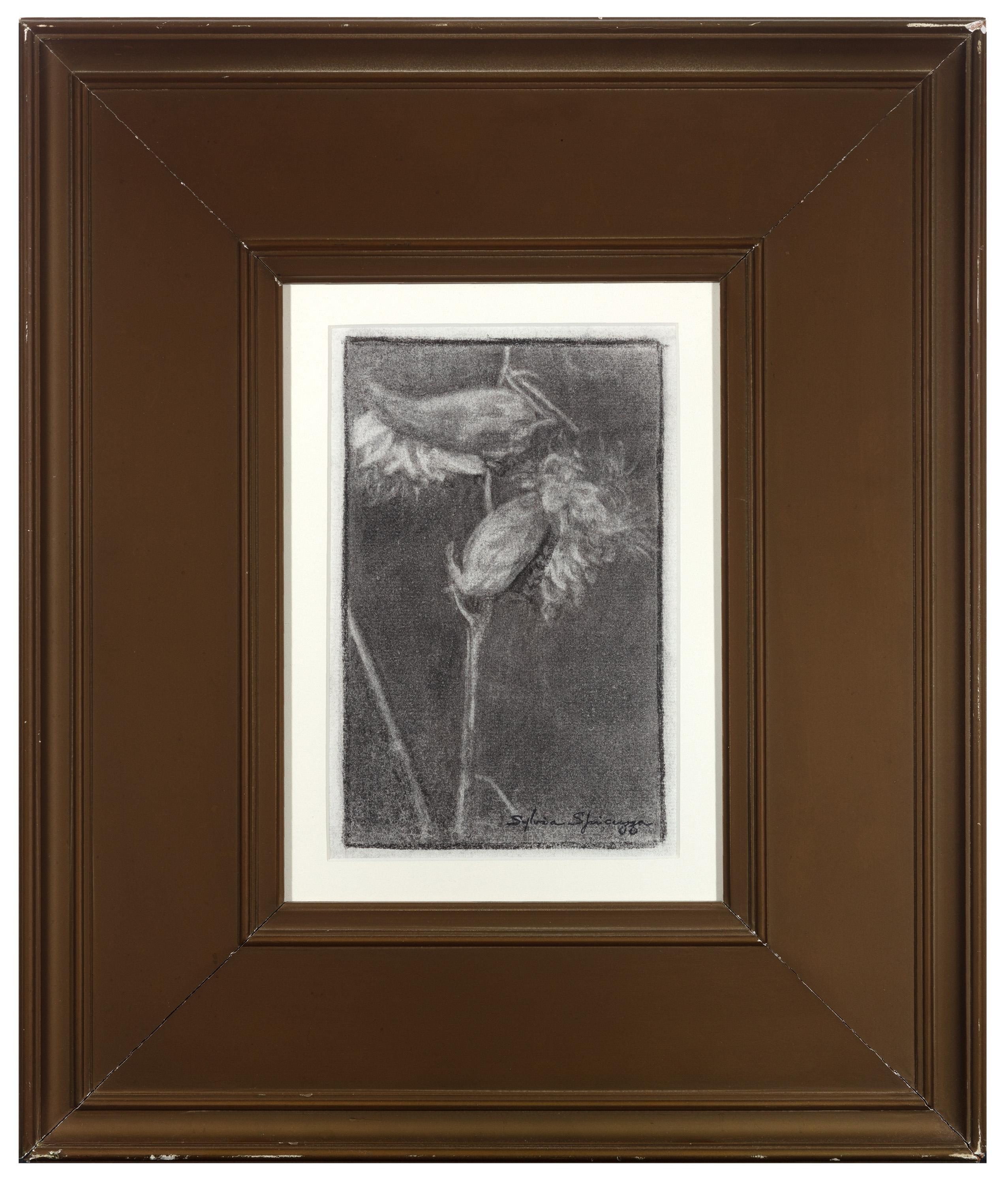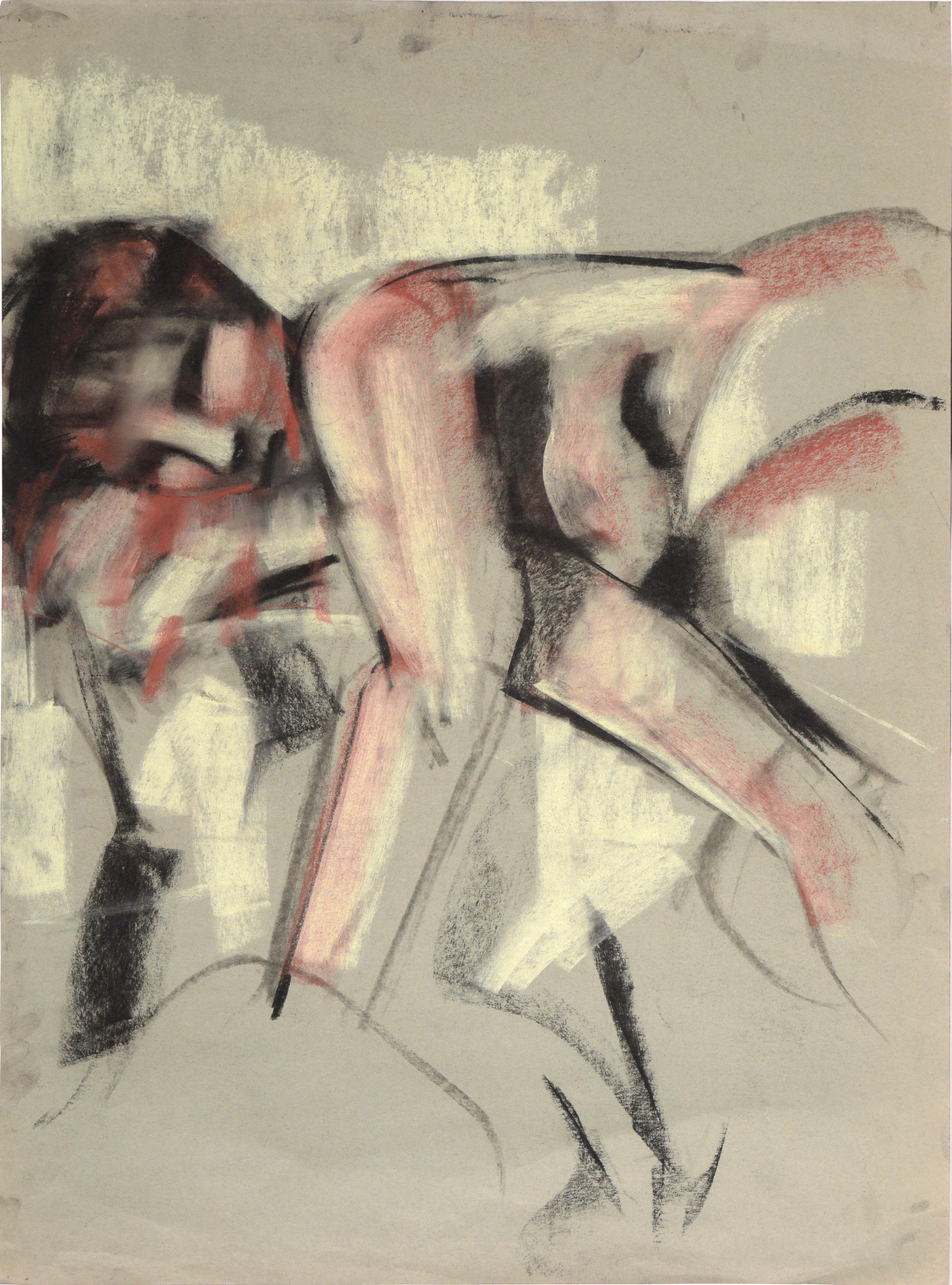Items Similar to Untitled (Young woman seen from the back)
Want more images or videos?
Request additional images or videos from the seller
1 of 10
Paul César HelleuUntitled (Young woman seen from the back)c. 1910
c. 1910
About the Item
Untitled (Young woman seen from the back)
Sanguine crayon, charcola and watercolor on paper, c. 1910
Signed with the estate stamp, Lugt 5169 lower left corner
Provenance:
Estate of the artist (see estate stamp signature)
Galerie J. Le Chapelin, 71 Rue Faubourg Saint-Honoré, Paris (highly respected gallery in the 1950s)
Private Collection, New Jersey
Condition: Slight vertical crease in the paper left side of image.
Tiny spots of staining.
Image/Sheet size: 11 1/2 x 11 3/4 inches
Paul César Helleu was born in Vannes, Brittany, France. His father, who was a customs inspector, died when Helleu was in his teens. Despite opposition from his mother, he then went to Paris and studied at Lycée Chaptal. In 1876, at age 16, he was admitted to the École des Beaux-Arts, beginning academic training in art with Jean-Léon Gérôme. Helleu attended the Second Impressionist Exhibition in the same year, and made his first acquaintances with John Singer Sargent, James McNeill Whistler, and Claude Monet. He was struck by their modern, bold alla prima technique and outdoor scenes, so far removed from the studio. Following graduation, Helleu took a job with the firm Théodore Deck Ceramique Française hand-painting fine decorative plates. At this same time, he met Giovanni Boldini, a portrait painter with a facile, bravura style, who became a mentor and comrade, and strongly influenced his future artistic style.
When he was 18 years old, Helleu established a close friendship with John Singer Sargent, four years his senior, that was to last his lifetime. Already becoming established, Sargent was receiving commissions for his work. Helleu had not sold anything, and was deeply discouraged almost to the point of abandoning his studies. When Sargent heard this, he went to Helleu and picked one of his paintings, praising his technique. Flattered that Sargent would praise his work, he offered to give it to him. Sargent replied, "I shall gladly accept this, Helleu, but not as a gift. I sell my own pictures, and I know what they cost me by the time they are out of my hand. I should never enjoy this pastel if I hadn't paid you a fair and honest price for it." With this he paid him a thousand-franc note.
Helleu was commissioned in 1884 to paint a portrait of a young woman named Alice Guérin (1870–1933). They fell in love, and married on 28 July 1886. Throughout their lives together, she was his favourite model. Charming, refined and graceful, she helped introduce them to the aristocratic circles of Paris, where they became popular fixtures.
On a trip to London with Jacques-Émile Blanche in 1885, Helleu met Whistler again and visited other prominent artists. His introduction to James Jacques Tissot, an accomplished society painter from France who made his career in England, proved a revelation. In Tissot, Helleu saw, for the first time, the possibilities of drypoint etching with a diamond point stylus directly on a copper plate. Helleu quickly became a virtuoso of the technique, drawing with the same dynamic and sophisticated freedom with his stylus as with his pastels. His prints were very well received, and they had the added advantage that a sitter could have several proofs printed to give to relations or friends. Over the course of his career, Helleu produced more than 2,000 drypoint prints.
Soon, Helleu was displaying works to much acclaim at several galleries. Degas encouraged him to submit paintings to the Eighth Impressionist Exhibition in May and June 1886. The show was installed in a Paris apartment at 1 rue Laffitte, which ran concurrently with the official Salon that year to make a statement. Although 17 artists joined the famous exhibit that included the first Neo-Impressionistic works, Helleu, like Monet, refused to participate.
Paul Helleu Sketching with His Wife (1889), by John Singer Sargent, The Brooklyn Museum, New York
In 1886, Helleu befriended Robert de Montesquiou, the poet and aesthete, who bought six of his drypoints to add to his large print collection. Montesquiou later wrote a book about Helleu that was published in 1913 with reproductions of 100 of his prints and drawings. This volume remains the definitive biography of Helleu. Montesquiou introduced Helleu to Parisian literary salons, where he met Marcel Proust, who also became a friend. Proust created a literary picture of Helleu in his novel Remembrance of Things Past as the painter Elstir. (Later, Helleu engraved a well-known portrait of Proust on his deathbed.) Montesquiou's cousin, the Countess Greffulhe, enabled Helleu to expand his career as a portrait artist to elegant women in the highest ranks of Paris society, portraits that provide the basis for his modern reputation. His subjects included the Duchess of Marlborough, the Marchesa Casati, Belle da Costa Greene, Louise Chéruit, and Helena Rubinstein.
Looking for new inspiration, Helleu began a series of paintings and color prints of cathedrals and stained glass windows in 1893, followed by flower studies and landscapes of parks in Versailles. Helleu took up sailing, owning four yachts over his life. Ships, harbor views, life at port in Deauville, and women in their fashionable seaside attire became subjects for many vivid and spirited works.
In 1904, Helleu was awarded the Légion d'honneur and became one of the most celebrated artists of the Edwardian era in both Paris and London. He was an honorary member in important beaux-arts societies, including the International Society of Painters, Sculptors, and Engravers, headed by Auguste Rodin, and the Société Nationale des Beaux-Arts.
On his second trip to the United States in 1912, Helleu was awarded the commission to design was the ceiling decoration in New York City's Grand Central Terminal. He decided on a mural of a blue-green night sky covered by the starry signs of the zodiac that cross the Milky Way. Although the astrological design was widely admired, the ceiling was covered in the 1930s. It was completely restored in 1998.
Helleu made his last trip to New York City in 1920 for an exhibition of his work, but he realized that the Belle Époque was over. He felt out of touch, and shortly after his return to France, he destroyed nearly all of his copper plates and retired to family life. While planning for a new exhibition with Jean-Louis Forain, he died in 1927 at age 67 of peritonitis following surgery in Paris.
Among many of his friends was Coco Chanel, who chose beige as her signature colour upon on his advice—the colour of the sand on the beach of Biarritz in early morning.
Courtesy Wikipedia
- Creator:Paul César Helleu (1859-1927, French)
- Creation Year:c. 1910
- Dimensions:Height: 11.5 in (29.21 cm)Width: 11.75 in (29.85 cm)
- Medium:
- Movement & Style:
- Period:
- Condition:Slight vertical crease in the paper left side of image.
- Gallery Location:Fairlawn, OH
- Reference Number:
Paul César Helleu
Rich impression with dramatic drypoint burr and tone no other artist epitomizes the whole atmosphere of elegance and hedonistic pleasure which pervaded Paris society at the first decade of the century as does Helleu. A close friend of Proust and the inspiration for one of the principal characters in La Recherche du Temps Perdu, Helleu’s whole life style echoed the incomparable elegance and flow of his drawing, the sheer style of his art, and his eye for the poses of the beautiful women who were his friends and his patrons. During the 1870’s, Helleu had come to know the painters of Impressionism and also artists Sargent and Whistler who became his special friends and inspiration. By the early 1880’s, he had already developed the quality of expressive sweeping line, which is the essence of his drawing, but in 1885 he was encouraged by Tissot to try working on prints in drypoint. At this time, Tissot had decided, after the death of his lover and model Kathleen Newton, to travel to the Holy Land on an artistic pilgrimage. Having decided he would no longer engrave, he gave Helleu his diamond stylus…a literal and figurative “passing of the baton”. It was in the incision and texture of drypoint that his art was to reach one of its greatest peaks. He had an innate feel for the balance between a lightly curving stroke and the deeply cut highly tonal burr of the strongest drypoint. Around the turn of the century he started to combine drypoint with multi-inking in colors, the areas of color restricted to such touches as the bows on the hats, the hair color or the red of the lips. The plate was drawn at a single sitting, and then the color inks were brushed onto it. The results are some of the most splendid and decorative of all Belle Époque prints.
About the Seller
5.0
Recognized Seller
These prestigious sellers are industry leaders and represent the highest echelon for item quality and design.
Platinum Seller
These expertly vetted sellers are 1stDibs' most experienced sellers and are rated highest by our customers.
Established in 1978
1stDibs seller since 2013
713 sales on 1stDibs
Typical response time: 1 hour
Associations
International Fine Print Dealers Association
- ShippingRetrieving quote...Ships From: Fairlawn, OH
- Return PolicyA return for this item may be initiated within 10 days of delivery.
More From This SellerView All
- "And wasn't it good for a boy to be Out to old Aunt Mary's"By Howard Chandler ChristyLocated in Fairlawn, OH"And wasn't it good for a boy to be Out to old Aunt Mary's" Charcoal and watercolor on artist illustration board, 1900 Initialed and dated lower right: H.C.C. 1900 by the artist (see...Category
Early 1900s American Impressionist Figurative Drawings and Watercolors
MaterialsCharcoal
- Girl with the Golden CurlsBy Everett ShinnLocated in Fairlawn, OHGirl with the Golden Curls Watercolor, c. 1895 Unsigned Provenance: Davis Galleries, New York (see photo of label on reverse) Condition: Mounted to support by the artist A few imperfections (bubbles) in the mounting Original frame Image size: 6 3/4 x 4 1/2 inches Frame size: 13-1/2 x 11-1/4 x 3/4 inches A charming pre Ashcan work by the artist. Done while he was making his living as a commercial illustrator for advertsing and magazines. Everett Shinn (1876-1953) In 1897, Shinn moved to New York City to work as an illustrator at the New York World. He became fascinated by the drama of the city. While visiting Europe in 1900, Shinn took interest in the work of the Impressionists, particularly those of Degas. Degas’ influence can be read in Shinn’s depictions of American theater. From his acquaintances in the theater world, Shinn began to paint decorative “rococo revivalist” murals in the homes of the wealthy elite. He also worked extensively in pastel, portraying the rough life of the city. In 1908, Shinn exhibited alongside his Charcoal Club associates, with the addition of Arthur B. Davies, Ernest Lawson, and Maurice Prendergast...Category
1890s American Impressionist Figurative Drawings and Watercolors
MaterialsWatercolor
- Woman with childBy Robert HallowellLocated in Fairlawn, OHWoman with child Watercolor on paper, c. 1930 Signed with the estate stamp lower right (see photo) Exhibited: Marbella Gallery, New York Illustrated: Robert Hallowell: An Artist Redi...Category
1930s American Impressionist Figurative Drawings and Watercolors
MaterialsWatercolor
- The Red DressBy Robert HallowellLocated in Fairlawn, OHThe Red Dress Watercolor on paper, mounted on board by the artist, 1926 Signed and dated, 1926 lower left (see photo) Condition: Mounted on support board by...Category
1920s American Impressionist Figurative Drawings and Watercolors
MaterialsWatercolor
- CourtshipBy Robert HenriLocated in Fairlawn, OHCourtship Graphite and black crayon, c. 1905 Signed by the artist in pencil lower left (see photo) Most probably inspired by a Paul Gavarni lithograph and executed while the artist w...Category
Early 1900s American Impressionist Figurative Drawings and Watercolors
MaterialsCrayon
- Sketch of a woman's head in profileBy Sir William OrpenLocated in Fairlawn, OHSketch of a woman's head in profile Graphite on paper, c. 1900-1910 Unsigned Condition: Excellent Tiny tear upper right near hinge (repaired and bearly visible) Sheet size: 4 5/8 x 3...Category
1910s Impressionist Figurative Drawings and Watercolors
MaterialsGraphite
You May Also Like
- Adolphe Appian (1818-1898) Les Bords de l'Ain (Shores of Ain), signed drawingBy Adolphe APPIANLocated in Paris, FRAdolphe Appian (1818-1898) Les Bords de l'Ain (Shores of Ain), signed lower left charcoal and white chalk on paper 36 x 45 cm In quite good condition : foxings in the upper part (...Category
1860s Impressionist Landscape Drawings and Watercolors
MaterialsCharcoal
- At the trough Paper, charcoal, 51.5x34.5cmLocated in Riga, LV"At the Trough" is an artwork created on paper using charcoal. The dimensions of the artwork are 51.5x34.5 cm. The composition features a woman and a trough, suggesting a rural scene related to feeding and gathering water. The use of charcoal as the medium creates a rich, textural effect in the artwork. The focal point of the composition is the woman, who is the central figure in the scene. The artist has depicted her with a sense of realism, capturing her features, gestures, and expression. Zigurds Gustins (1919-1950) Graphic artist, teacher. Born in family of peasants. Biruta Gustynya wife - painter and teacher. He graduated from the agricultural high school Mezhotne (1937). He studied at the Latvian Academy of Art (1937-42), member of the student corporation "Dzintarzeme". From 1942 he worked in the management of monuments, drew antiques...Category
Early 20th Century Impressionist Figurative Drawings and Watercolors
MaterialsPaper, Charcoal
- Ships at the Harbor - Nautical Seascape with Seagulls in Charcoal on PaperLocated in Soquel, CAShips at the Harbor - Nautical Seascape in Charcoal on Paper Detailed and layered harbor scene by Maude Folmar Ramsey (American, 1908-1993). The viewer is looking out at the harbor, across the water from the docks, buildings, and ships. The pillars, buildings, and masts are jumbled together in a pleasing manner that is almost abstract. Despite the simplified shapes, this piece is full of detail. This piece is executed in a rectilinear style frequently seen in American mid-century modern compositions. Signed in the lower right corner "Maude Folmar" Presented in a wood frame with a double mat. Frame size: 25.25"H x 29.25"W Image size: 17"H x 21.5"W Maude Love (Folmar) Ramsey (American, 1908-1993) studied at the School of Fine Arts at Washington University in St. Louis, Missouri. She was the director of the Laguna Gloria Art Museum from 1968-1972. Ramsey was one of the charter members of the “Waterloo...Category
Mid-20th Century American Impressionist Landscape Drawings and Watercolors
MaterialsPaper, Charcoal
- "Summertime Fun at Big Cedar Lake" original charcoal drawingBy Sylvia SpicuzzaLocated in Milwaukee, WIIn this drawing, Sylvia Spicuzza presents the viewer with a scene of two young women relaxing on a dock in a lake. A dinghy floats beside them as other boats traverse the water. This drawing is reminiscent of the work done by her father Francesco, who is better known for landscapes in the Impressionist style. 12 x 9 inches, artwork 18.63 x 15.75 inches, frame Stamped with artist's signature, lower right Born in 1908, Sylvia Spicuzza was the daughter of noted painter Francesco Spicuzza. Sylvia devoted herself to teaching art to the students of Lake Bluff...Category
1950s American Impressionist Figurative Drawings and Watercolors
MaterialsCharcoal
- "Milkweed Pod I #528" Original Charcoal DrawingBy Sylvia SpicuzzaLocated in Milwaukee, WIIn this drawing, Sylvia Spicuzza presents the viewer with a dark, subtle view of two milkweed pods, bursting forth with cotton. Examples like this show the ability of Spicuzza to draw in a naturalistic style, where most of her work is usually in a highly stylized, graphic mode. The richness and depth of the black charcoal makes for a moody image. 8 x 5 inches, artwork 18 x 14.5 inches, frame Born in 1908, Sylvia Spicuzza was the daughter of noted painter Francesco Spicuzza. Sylvia devoted herself to teaching art to the students of Lake Bluff...Category
1920s American Impressionist Figurative Drawings and Watercolors
MaterialsPaper, Charcoal
- Nude Women in Charcoal on Paper (Two Sided)Located in Soquel, CANude Women in Charcoal on Paper (Two Sided) Nude woman laying down by Santa Cruz and San Francisco artist Heather Speck (American, b. 1978). On the ...Category
Early 2000s American Impressionist Nude Drawings and Watercolors
MaterialsPaper, Charcoal
Recently Viewed
View AllMore Ways To Browse
Watch Makers Henry
His And Her Antique Small Watercolor Paintings
Alfred Roller
Martin Brad
Burlesque Feather Boa
Watercolours And Drawings
Kali Maa
La Montre Molle Dali
Las Vegas Memorabilia
M Lemieux
Maa Kali
Reinhart Ad
Sheep Head Sofa
Versus Gallery Munich
Wax Lyrical England
William H Sullivan
Andy Warhol Oyster
Avis Diamond Galleries
